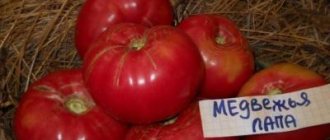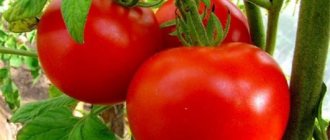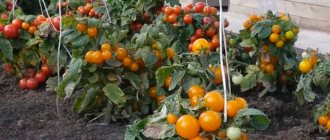| Ripening period: | early |
| Shape, weight of fruits: | flat-round, 200-300 g |
| Bush type: | determinant |
| Growing regions: | everywhere |
| Productivity: | up to 12 kg per sq. m |
The popularity of beef tomatoes is great all over the world, and it is not going to decline. If previously in most regions of Russia they could only be grown in greenhouses, now the situation has changed. Every year new varieties with large, fleshy fruits come onto the market and manage to gain sweetness even in the short summer. The Bear's Blood tomato didn't get lost in the crowd either.
Tomato Bear's Blood: the history of the variety's creation
Tomato Bear's Blood
The Bear's Blood variety was developed by several breeders. The crossing took place in Nizhny Novgorod and before it was successful, a lot of work was done, as a result of which a new variety appeared. The new variety has passed all tests. It has proven to be productive, well adapted to a temperate climate and little change in the environment. Bear blood began to be sold only recently, but the variety is slowly gaining popularity.
Similar varieties
Tomatoes are similar in characteristics to Bear's Blood:
- Alsou. Tomato from agro, in the State Register since 2008. Early for open ground, determinate, with a bush height of about 80 cm. Tomatoes are flat-round in shape, red, fleshy, slightly ribbed, average weight without standardization - 300 g, chambers - 6 or more. Marketable yield per sq. m – 7 kg, total – higher.
- Big jackpot. The tomato is not included in the State Register; the selection is from the Siberian Garden. Determinate, early, long-term fruiting, up to 90-100 cm high. Recommended for open ground. The tomatoes are flattened, dark red, with faint ribs. The pulp is sweet, fleshy. From 1 sq. m harvest up to 12 kg.
- Vologda fruitful. Mid-early for open ground. Determinate, up to 1 m high. 250-400 g, fleshy tomatoes, multi-chambered, bright red, compressed at the poles. The tomato yields a harvest of up to 4 kg per bush.
Bear's blood is a new variety, all the features of which gardeners have yet to study. But the tomato has already shown itself to be productive and tasty. The fact that it requires compliance with the rules of agricultural technology cannot be considered a minus.
Tomatoes Bear's Blood: a detailed description of the tomato variety
Tomatoes Bear's Blood: photo
This variety was created specifically for cultivation in temperate climates, in open ground. If the climate is colder, then it is recommended to plant in closed ground, that is, in film or glass greenhouses. The plant tolerates various frosts well and also produces a fairly large, regular harvest. The variety is resistant to short-term drought. All processes in a tomato occur regardless of the presence of sunlight; this variety is very different from its peers, since many tomatoes cannot produce photosynthesis without the sun. It belongs to the early ripening varieties. For the fruits to fully ripen, it usually takes about 90 days after transplanting into open or closed ground.
Description of the plant
The average height of the variety usually ranges from 80 to 100 centimeters; it belongs to varieties of medium growth, and it is also worth noting that growth stops after the bush has flowered. The bush is not spreading, but has several lateral stems; these stems are not used when forming. The variety must be formed by only one, the main shoot, which is located in the center, the rest will have to be removed. To ensure large fruits, some of the ovary is removed.
Description of the Bear's Blood tomato bush
- Loose arrangement of leaves, leaves are quite small. The leaf itself is dark green in color with teeth along the edge, the surface of the leaf looks like corrugated paper, and it is also covered with a small fluff. The top of the leaf has a darker shade than the bottom.
- The main stem, which is located in the middle, is very thick and strong, it has a brownish color with a green tint. The shoots growing on the sides are light green in color and very poorly developed.
- The crop is bisexual, so it pollinates itself and does not require additional pollinating plants. The flowers are deep yellow during the flowering period.
- The root system belongs to the fibrous system. It grows quite well and forms a circle with a diameter of about 70 centimeters.
- The bunch of tomatoes is quite dense, about 6-8 ovaries. The brushes are located after 1-2 sheets. When forming, you should leave only 4-5 clusters on the bush, which are strong and will bear fruit; each cluster should have about 5-6 tomatoes. Since the variety is large-fruited, the ovaries will not develop in large quantities, and you may be left completely without a harvest.
Fruit ripening occurs unevenly. The first collection is already carried out in mid-August, and the last collection 10-20 days before the first frost. It is worth noting that when grown in a greenhouse, the first harvest will take place in early August.
Note: This variety is one of the few varieties that produce whole seeds. These seeds retain all the information about the variety.
Description of the fruits of the Bear's Blood tomato variety
- The fruits are round in shape with fairly high shoulders, the surface is divided into unequal parts. Each tomato weighs on average about 400 grams; if the density of the bunch is normal, then they reach up to 700 grams.
- They have a uniform color, the skin is uniform, without bumps and shiny.
- The skin is dense and protects the fruit well from injury, so during long-term transportation they do not crack, but remain the same.
- The pulp has a pleasant aroma and taste, the tomato is very fleshy and loose, and also has many chambers. Usually the fruits do not have white parts.
- The sweet taste of tomatoes without sourness manifests itself with proper care.
- The seeds are ivory colored and quite large in size.
After the fruits have been collected, the tomato remains the same for 10-15 days. This variety is perfect for sale, as well as for ordinary home preparations, since tomatoes are universal and can be used anywhere. You can make juices, pastes, ketchup from them, or you can simply eat them fresh.
Features of cultivation
From the description of the variety and photos of Bear's Blood tomatoes, it becomes clear that the requirements for agricultural technology for the variety are standard. It is necessary to sow the hybrid as seedlings and then transfer it to a greenhouse or open soil.
Planting seedlings
The seeds of the Bear's Blood hybrid are sown on seedlings in mid or late March. It is necessary to prepare shallow wide boxes, as well as a soil mixture consisting of compost, peat, garden soil and sand. Before use, the soil and container are spilled with a solution of potassium permanganate or scalded with boiling water.
The seeding algorithm looks like this:
- The container is filled with pre-moistened soil.
- Seeds are placed in grooves 1-2 cm deep at intervals of 3 cm.
- Sprinkle the grains on top with a thin layer of soil.
- Moisten the substrate and cover the container with film.
Until greenery appears, the box is kept at 22 ° C in a slightly shaded place. After the seedlings have formed, the film is removed, the container is moved to a sunny windowsill and watered from time to time.
After a week and a half, the seedlings are planted for the first time in separate containers. The seedlings are replanted in larger containers after another 14 days.
Attention! Before sowing, tomato seeds need to be disinfected and soaked in a growth stimulator, especially if we are talking about personally collected material.
If there is a lack of sun, tomato seedlings are illuminated up to 16 hours a day.
Transplanting into a greenhouse or in the ground
The seedlings are transferred to a greenhouse or open ground in the middle or at the end of May after the return frosts have passed. In a well-lit area, dig up the soil and spill it with copper sulfate, and then prepare holes that are approximately twice the size of the roots.
The seedlings, together with the old earthen ball, are transferred to the recesses in the morning or evening, in the absence of sun, and watered abundantly. It is recommended to place 2-3 bushes per 1 m2.
Aftercare
Caring for the Bear Blood hybrid comes down to a few simple procedures:
- Watering. It is recommended to moisten tomatoes weekly with 5 liters of water per bush. During the flowering and fruiting period, the watering rate is reduced to 2-3 liters of water.
- Feeding. Three times a season, complex minerals and organic matter are added to the soil at the roots of the plant - mullein infusion or ash solution. Fertilizing is carried out at the beginning of flowering and twice during fruit ripening.
- Mulching. So that the tomato suffers less from weeds and the soil at the roots does not dry out, the beds are covered with a layer of straw or hay.
- Stepsonning. The culture is carried out in 1-2 stems, removing side shoots as they grow.
The fruits of the Bear's Blood variety are very large, so the stem and brushes must be tied to a support. The procedure is first carried out after the bushes reach a height of 50 cm.
Tomato Bear's Blood: main characteristics
Tomato Bear's Blood: photo of the variety
Bear's blood is a tomato variety that tolerates frost and drought well. During the growing season, it functions well even at night when the outside temperature drops. When grown in a greenhouse, the plant develops even better, since there is no need to waste energy on warming. When the soil dries out a little, the variety feels comfortable, but if you start adding excess moisture to the soil, the root system may begin to rot and the plant will die.
Tomatoes of the Bear's Blood variety are characterized by regular and high yields, while the process of fruit formation is not affected by weather or climate factors. The yield level when grown in open and closed ground is almost the same, the only difference is that in a greenhouse tomatoes ripen 2-3 weeks earlier.
When planting in open ground, you don’t have to worry about part of the plot; the variety can also be planted in the northern part of the territory. The best option for this variety would be to have a small building nearby, since there will be no draft, which the variety does not tolerate very well. The bush will develop equally in a sunny or dark place; the sun's rays do not spoil the fruits due to the dense shell.
Since the variety is a medium-sized variety, it produces good yields. The average yield from each bush is about 4 kilograms. For a good harvest, the distance between the bushes must be maintained at about 20-25 centimeters. The bush requires minimal care and does not require anything additional.
The first wave of tomatoes grown indoors will ripen by the end of July and harvesting can begin in early August, the last wave will end around the beginning of October or the end of September. If the fruits are not fully ripened, there is no need to worry, you just need to put them in a dark place and they will ripen on their own. Tomatoes growing in open ground are harvested at the end of summer.
The fruits of this variety have a strong immune system; when changes were made to the variety, it was given resistance to major diseases, such as fusarium, late blight, and cladospora.
When grown in a greenhouse and the temperature and humidity are not maintained, a tomato can be affected by fungal diseases, for example, microsporia. Such diseases most often appear on leaves and shoots. In order to get rid of the fungus, you need to remove infected leaves and shoots, ventilate the greenhouse, add nitrogen fertilizer to the soil and treat the surface of the bush with a product with a high copper content. Pests in a greenhouse are not terrible, but in open ground Colorado beetles can settle on a bush. In this case, the bush is treated with Chlorophos.
Advantages and disadvantages
This variety has a lot of positive reviews, but due to the fact that it went on sale quite recently, most gardeners have not yet planted it.
Pros:
- High yield level, it does not depend on the amount of sunlight, water, temperature changes, changes in the environment.
- Delicious and aromatic large tomatoes.
- Long-term storage of fruits without changes in appearance and taste.
- The variety does not stop growing even at low temperatures, about +14 degrees.
- The bush is quite compact and does not occupy much territory.
- It is enough to devote a little time to the variety and perform basic care for it.
- High resistance to infections and pests.
- The place of cultivation, in open or closed ground, does not matter. In any case, the crop will give a good harvest.
Minuses:
- Due to the large size of the fruits, they need support, since without tying the stems can break.
- The fruits ripen in several waves, that is, unevenly.
Resistance to diseases and pests
The State Register says nothing about the susceptibility of the variety to diseases. The breeder, agro, declares good immunity and high resistance. Gardeners, even those who scold the tomato for real or imaginary shortcomings, note that it actually gets sick less than other tomatoes.
Preventative treatments still need to be done. It is recommended to spray the bushes and water the soil with a solution of Fitosporin or Trichoderma.
Planting seedlings
This variety is grown by seedlings, that is, before transplanting it into open or closed ground, the Bear's Blood tomato seeds must be sown at home and wait until the sprouts of the required height appear. Sowing of seedlings is carried out in early April, and transplantation is carried out 50 days after planting the seedlings.
Before planting seedlings, you need to prepare everything you need. For this we need containers, they can be any kind, either wooden or plastic, it doesn’t matter. You also need Bear's Blood tomato seeds and prepared soil where the seeds will be planted. To prepare the soil, it must be fed with a mixture that includes peat, sand, turf layer, and 50 grams of nitrogen.
Landing instructions
- You need to put soil in the container and water it.
- Make grooves, the depth of which should be about 2 centimeters; there should be a distance of 1.5 centimeters between the grooves.
- Bear's blood tomato seeds are placed in grooves and covered with soil.
- Then the soil must be covered with film or glass.
- Place the container in a room where the temperature is +24 degrees.
When the first shoots appear, the shelter must be removed and fairly regular watering should begin, about 2 times every 7 days. When four leaves appear on the sprouts, you can start feeding the plant using a small amount of complex fertilizer. A day after fertilizing, the seedlings should be planted in peat cups and kept there for about 7 days. After this, they can be transplanted into the ground.
Transplantation into open or closed ground
The bushes are transplanted at the end of spring, or more precisely in the second half of May. If the sprouts are in peat cups, then they can be placed in the ground directly in the cups. If the sprouts are in plastic cups, then they should be cut and planted together with the soil from the container. If the site is not protected, then it is planted there only after the earth has warmed to +18 degrees. Note: To ensure good rooting in a new location, the plant should be covered at night for days after transplantation.
Tomatoes Bear's blood: care
Caring for the Bear's Blood variety is very simple and basic, and therefore does not require much time and effort.
- The bush should be formed by only one central shoot, and the rest should be removed.
- It is necessary to loosen the soil, since the root system needs air.
- It is necessary to clean the soil from weeds and other debris.
- Installing a support and tying the bush is necessary when there are a lot of brushes and fruits on the bush. Otherwise, the brushes may break off along with the fruit.
- Watering should be moderate; under no circumstances should excess water be added to the soil, as the root system may begin to rot.
- After transplanting into the ground, it is necessary to mulch using straw.
- Fertilizer is applied approximately once every 30-35 days. You can use organic or complex fertilizers.
Description of the plant
The variety received its funny name due to the distant similarity of its fruits to a bear’s paw. Rich red tomatoes are distinguished by their large size and rounded-flattened shape, with ribbing observed near the stalk. The glossy skin covers the juicy and fleshy pulp of the fruit. One tomato can weigh 700−800 g. The variety is loved by summer residents for its bright sweet taste with a sour aftertaste and a tart aftertaste.
Characteristics of the variety
The tomato is an indeterminate variety. It grows up to 2 meters in height, so it is often grown in high greenhouses, where it is easier to build reliable supports to support developing bushes. The stems are densely covered with dark green leaves.
4-6 fruits ripen on small clusters. The mid-season variety ripens 100−110 days after planting the seedlings. One bush brings up to 30 kg of tomatoes.
The fruits are eaten fresh or canned. Bear Paw tomatoes are used to make tomato paste, sauces, purees and juices.
Among the advantageous characteristics of the variety are:
- High yield;
- Counteracting late blight and other diseases;
- Resistance to drought and cold;
- Possibility of transportation;
- Long-term storage;
- Easy to care for.











